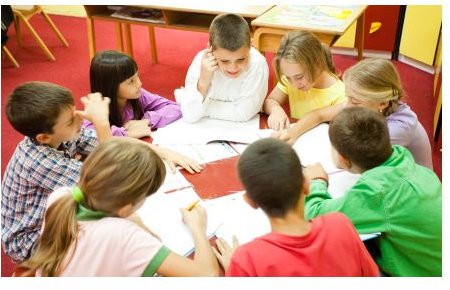Balancing Collaborative Learning With Discipline in Today's Classrooms
Collaborative Learning: At the Core of Common Core
According to the Global Development Research Center, collaborative learning is, “an educational approach to teaching and learning that involves groups of learners working together to solve a problem, complete a task or create a product.” For states that have adopted Common Core Standards, collaborative learning is a vital component of 21st century classroom education.
Students are challenged in a collaborative learning environment to thoughtfully articulate – and finally, defend – their ideas to small groups of diverse students.
This exercise leads students to start constructing their own ideas, beliefs and framework and not rely only on experts. Learners converse and exchange diverse beliefs, question ideas and are actively engaged in the discovery process. The development of crucial critical thinking skills and a departure from group-think are the desired outcomes.
Setting up Students for Success
In a collaborative learning environment, students are free to discuss and share their thoughts, ideas and beliefs - this will not be a silent classroom. Nor should teachers expect a calm environment!
Building this type of learning backdrop is a process, but educators should start experimenting with small groups for limited amounts of time immediately. It is imperative to get students used to the concept of this type of learning style, especially if they have not previously been exposed to the practice.
The key, however, to a successful collaborative learning environment is classroom discipline. Several discipline guidelines better the odds for a positive classroom atmosphere that helps the process along.
- Explain the assignment, behavior expectations and consequences for not staying on task.
- Create diverse groups of students with varying opinions, abilities and beliefs. Make sure the same students do not always work together. That said, be sure to closely monitor for students with strong differences of opinion to prevent harsh criticism or even bullying.
- Answer questions before starting a session to eliminate any confusion. Make sure students clearly understand the assignment.
- Consider assigning each group member a task, or ask them to rate group members’ participation. These ideas encourage students to participate in group discussions and work.
- Monitor student progress and their percentages of on-task work. Teachers should be up and walking around the classroom, not sitting behind a desk or engaged in multi-tasking. Even though learners seem to be taking the lead in this classroom, it is the educator who actually holds the reins.
- Stop any disruptive or off-task behavior immediately and follow through with stated consequences.
- Highlight or compliment students who are on task and working diligently; catch them doing something right! All students like to be recognized.
It is essential for teachers to maintain control of both the classroom and the activity in order for students to find value in a collaborative learning environment. Educators must enforce established discipline and procedures to create a successful classroom atmosphere conducive to this sometimes challenging – but always rewarding – practice.
Effective Use Suggestions
Think - Pair - Share:
Teachers ask a question requiring higher order thinking skills and allow the students a few minutes of think time. Students may also write notes to gather their thoughts. Students share responses with a partner. After partners have shared, pair two partner groups together to share responses and continue the discussion.
Group Investigations:
Assign students a topic for investigation. Students then divide the investigation topic into smaller parts, and each group member is responsible for researching one of the subtopics. Learners reconvene and share learned information, all the while analyzing how to produce an end product. The investigation concludes with a group presentation.
Numbered Heads:
Place students in small groups of three or four. Assign each member a number 1, 2, 3, etc. Groups work together to answer the questions so all members can effectively provide a response. The teacher randomly calls out one of the numbers assigned (i.e. ’three’) and each number three must provide their groups’ responses. Students do not know which number will be called so all group members must be prepared to answer.
References
- Global Development Research Center, http://www.gdrc.org/kmgmt/c-learn/what-is-cl.html
This post is part of the series: Cooperative Learning Lesson Plans
Use these cooperative learning lesson plans that help students work together to practice skills and work individually to show mastery.
